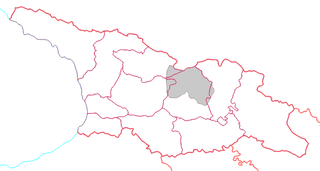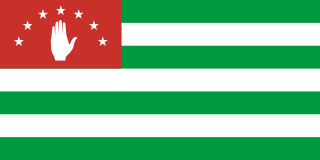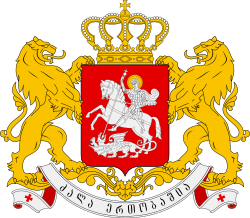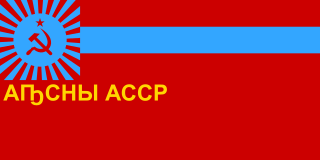
The subdivisions of Georgia are autonomous republics, regions, and municipalities.
Politics in Abkhazia is dominated by its conflict with Georgia. Abkhazia became de facto independent from Georgia after the 1992–1993 war, but its de jure independence has only been recognised by a few other countries. Abkhazia is a presidential representative democratic republic with a multi-party system, wherein the President is both head of state and head of government. Executive power is exercised by the government of the Republic of Abkhazia. Legislative power is vested in both the government and the People's Assembly of Abkhazia.

The Abkhaz–Georgian conflict involves ethnic conflict between Georgians and the Abkhaz people in Abkhazia, a de facto independent, partially recognized republic. In a broader sense, one can view the Georgian–Abkhaz conflict as part of a geopolitical conflict in the Caucasus region, intensified at the end of the 20th century with the dissolution of the Soviet Union in 1991.

The Georgian–Ossetian conflict is an ethno-political conflict over Georgia's former autonomous region of South Ossetia, which evolved in 1989 and developed into a 1991–1992 South Ossetia War. Despite a declared ceasefire and numerous peace efforts, the conflict remained unresolved. In August 2008, military tensions and clashes between Georgia and South Ossetian separatists erupted into the Russo-Georgian War.

South Ossetia, a mostly unrecognized republic in the South Caucasus, formerly the South Ossetian Autonomous Oblast within the Georgian Soviet Socialist Republic with its capital in Tskhinvali, held a referendum on independence on November 12, 2006.

The 1991–1992 South Ossetian War was fought as part of the Georgian-Ossetian conflict between Georgian government forces and ethnic Georgian militia on one side and the forces of South Ossetia and ethnic Ossetian militia who wanted South Ossetia to secede from Georgia and become an independent state on the other. The war ended with a Russian-brokered ceasefire, signed on 24 June 1992, which established a joint peacekeeping force and left South Ossetia divided between the rival authorities.
On 14 April 1978, demonstrations in Tbilisi, capital of the Georgian SSR, took place in response to an attempt by the Soviet government to change the constitutional status of languages in Georgia. After a new Soviet Constitution was adopted in October 1977, the Supreme Soviet of the Georgian SSR considered a draft constitution in which, in contrast to the Constitution of 1936, Georgian was no longer declared to be the sole State language. A series of indoor and outdoor actions of protest ensued and implied with near-certainty there would be a clash between several thousands of demonstrators and the Soviet government, but Georgian Communist Party chief Eduard Shevardnadze negotiated with the central authorities in Moscow and managed to obtain permission to retain the previous status of the Georgian language.
The Sukhumi riot was a riot in Sukhumi, Abkhaz Autonomous Soviet Socialist Republic, Georgian Soviet Socialist Republic, Soviet Union, in July 1989, triggered by an increasing inter-ethnic tensions between the Abkhaz and Georgian communities and followed by several days of street fighting and civil unrest in Sukhumi and throughout Abkhazia.

The Provisional Administration of South Ossetia is an administrative body that Georgia regards as the legal government of South Ossetia. The administration was set up by the Georgian government as a transitional measure leading to the settlement of South Ossetia's status. As of 2007, Georgia is proposing the status of autonomous republic within the Georgian state. The area mainly lies within the Shida Kartli region.

This article describes the background of the Russo-Georgian War.

Abkhazia, officially the Republic of Abkhazia, is a de facto and partially recognized republic on the eastern coast of the Black Sea, south of the Greater Caucasus mountains, in northwestern Georgia. It covers 8,660 square kilometres (3,340 sq mi) and has a population of around 240,000. Its capital is Sukhumi and it is recognised as a state by Russia, Venezuela, Nicaragua, Nauru and Syria. While Georgia lacks control over Abkhazia, the Georgian government and most United Nations member states consider Abkhazia legally part of Georgia, whose constitution designates the area as the Autonomous Republic of Abkhazia.

Georgia–India relations are foreign relations between Georgia and India. The Embassy of India in Yerevan, Armenia is concurrently accredited to Georgia. Georgia maintains an embassy in New Delhi.

A referendum on the future of the Soviet Union was held on 17 March 1991. The question put to voters was

An independence referendum was held in South Ossetia on 19 January 1992. The voters answered the questions: "Do you agree that South Ossetia should be an independent country?" and "Do you agree with the South Ossetian parliament solution of September 1, 1991 on reunion with Russia?" The proposals were approved by 99.9% of voters.

The Ukrainian sovereignty referendum was conducted on March 17, 1991, as part of the first and only Soviet Union referendum. Throughout the Ukrainian Soviet Socialist Republic, voters were asked two questions, with an additional question attached to the ballot in the historical region of Galicia which includes the Ukrainian provinces of Ivano-Frankivsk, Lviv, and Ternopil.
Ilia Chavchavadze Society is a political organisation from Georgia. The group dates back to the days of the Soviet Union, where it was an important factor in the growth of Georgian nationalism.





















